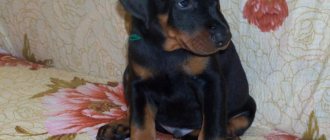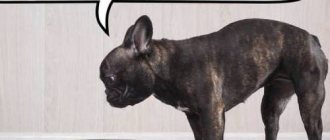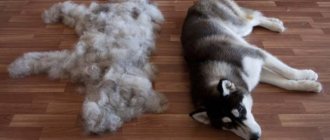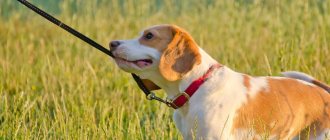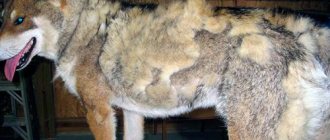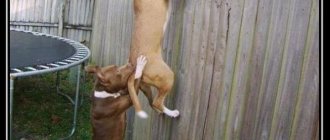Dog owners know very well that when a dog is healthy, it has a good appetite and looks cheerful. Adult dogs are fed by their owners twice a day; puppies and young dogs are fed more than twice a day. When a dog refuses its next meal, animal owners should not worry because... this will in no way affect her health. A dog owner should be concerned if your friend refuses food for 36-48 hours.
Physiology of estrus
Estrus (or estrus, estrous cycle) is a period in a dog’s life during which it is capable and ready to mate and fertilize. If the owner is determined to give birth to the dog,
then a mating with a male dog is organized. If the owner does not want to breed a dog, the owner must take measures to limit contact with uncastrated male dogs on walks and at home.
The time of the onset of the first heat depends on many factors: breed, size of the dog, individual characteristics. As a rule, for the first time in small breeds it occurs at 6-8 months, and in large breeds by a year. If the dog is more than 2 years old, but has never been in heat, you should consult a veterinarian. The noticeable part of the estrus cycle lasts an average of 3 weeks. And only part of this time the dog may have spotting. But let's take a closer look at what stages there are in estrus and the sexual cycle and how they manifest themselves.
Every heat has four stages. The first is called the precursor, and it lasts 7-10 days. At this time, you may notice that your cheerful and gentle dog has changed his behavior. The animal will become less predictable, begin to respond poorly and follow commands, and sometimes even show aggression, especially towards males. The dog may seem sad, lethargic, apathetic, lie in one place for half a day and sleep. At the same time, the appearance of the pet’s genitals also changes. The loop increases in size, swells (due to blood flow) and bloody discharge begins to appear from it. Usually it is by this sign that the owner understands that his dog is in heat. However, these secretions are not always noticeable, especially in small breeds.
The second phase of estrus is often called sexual heat. It also lasts 7-10 days, and it is during this time that the dog ovulates, which means successful fertilization can occur. Ovulation usually occurs on the 13th day from the start of estrus. The loop still remains swollen, but the discharge from it changes: it becomes almost invisible, lighter, and sometimes transparent. Your pet's behavior will change again, but this time in a different direction. The dog itself will show that it is ready for mating. She can become more affectionate, friendly and with her behavior show the males that they can approach her.
The third stage of diestrus lasts about 60 days. All external manifestations of estrus gradually disappear: the dog’s typical behavior returns, as does the previous appearance of the external genitalia. However, the dog owner should still be sensitive to his pet. After all, it is at this time that an unpleasant side effect of estrus can develop - false pregnancy.
Source
The dog is lethargic. Dangerous and non-dangerous signs.
Dangerous and not so symptoms of apathy in a dog. The first signs of how to treat and prevent apathy.
It is common for a person to wake up sleep deprived after a hard day at work or a night at the club. This condition is rare for animals. They don't get up with a broken head. If a usually active and cheerful dog does not get up all day and does not want to go outside for a walk, then you should worry about its health.
Apathy is a state when a dog does not want to play, eat, or walk. She wants to be left alone. This condition can be caused by various reasons. Many are not dangerous to health, but there are exceptions.
What not to do
If a dog doesn’t eat anything, you shouldn’t force it, scold it, or even beat it. This will lead to the fact that the pet will begin to associate food with punishment and will avoid it. Some owners, on the contrary, try to feed their pet treats, seeing that he does not want to eat his usual food. This leads to the fact that it becomes more profitable for the animal to beg for a treat from the owner’s hands than to eat from a bowl.
For your information! There is no need to change the diet and leave food available to your pet at any time. The dog will get used to the fact that the meat allotted to it will not go anywhere, which means that it is possible not to eat the entire portion and eat whenever it is convenient for it. This disrupts the feeding schedule and worsens the functioning of the gastrointestinal tract.
If the dog has stopped eating, there is no need to force it, feed it by hand, or offer more tasty food. It is important to stand your ground and not feel sorry for your pet. The owner should give him the same dry or natural food, and if the animal refuses, remove it until the next feeding. At first, the dog may not eat anything and only come to the bowl to sniff the food, but over time it will become hungry and accept the owner's conditions.
There is no need to beg your dog to eat or force feed it, this will only worsen the situation.
Non-dangerous signs of lethargy in a dog
Dog age
Your dog is aging and this will inevitably lead to changes in behavior. She becomes less mobile, and playing games while walking tires her out faster.
Old age cannot come suddenly. Usually such changes occur gradually. The period of old age begins at different times for all dogs. Usually closer to eight years. You will definitely notice such changes.
It is important to treat an older dog appropriately. Take her to the vet more often. At least once every three months. Change your pet's diet. There are many special foods for older dogs. Also, do not forget that an older dog moves less, and therefore may gain excess weight. Don't overfeed your dog.
Try to play outside with your older dog more often, but don't overdo it. Physical activity will help prolong your pet's life.
Depressive state
If you rarely pay attention to your pet, then such an attitude can cause serious psychological illnesses in him. Frequent absence of the owner makes the dog feel lonely, which can lead to depression. Try to spend time with your dog as often as possible.
State of fatigue
Your pet may simply be tired. He should not be constantly cheerful and cheerful. Do not think that after a walk and active games he does not need to rest.
Excess weight
An overweight dog has difficulty moving much. You should contact your veterinarian, he will select a special diet and take the necessary tests.
The dog has eaten too much
Regular overeating can cause discomfort in the stomach, which will lead to the desire to lie down and not get up from your favorite place. You should not demand activity and games from your dog immediately after eating.
Dog in position
Pregnancy leads to changes in a dog's behavior. Examine the dog, you may notice that the belly has become enlarged and the nipples are swollen. These are the first signs of pregnancy.
Possible consequences
The most obvious development is exhaustion. Constant starvation leads to significant weight loss, and the animal may die. This happens if the pet loses about 10–20% of its body weight as a result of food refusal.
A negative consequence may also be disruption of the gastrointestinal tract. This often happens if the pet is starving and the owner feeds it with treats. After just a week of this regime, the animal’s body will begin to work less efficiently, which can result in malfunctions and changes in stool.
A dog may refuse food for various reasons. The owner’s main task is to identify it in a timely manner and eliminate it before it leads to adverse consequences.
Guys, we put our hearts into Bright Side. Thank you for revealing this beauty. Thanks for the inspiration and goosebumps. Join us on Facebook and VKontakte
A responsible owner does not forget to care for his dog, gives vaccinations, carries out hygiene procedures and monitors the regime. But how can you notice in time that something is wrong with your pet and not miss the onset of a serious illness? Veterinarians say that not only dangerous syndromes, such as vomiting, bleeding or lameness, should alert the owner, but also changes in the dog’s behavior and reactions, and its character.
We at Bright Side drew attention to non-obvious signs that require taking your dog to a specialist. Some diseases in dogs, especially purebred ones, develop rapidly, and it is better to make a mistake in suspicion than to lose sight of something important. Particular vigilance must be exercised when the animal’s immunity may be weakened: during teeth changes, during periods of cold, extreme heat, and tick activity.
The dog's tail is hanging
If you notice that the dog has stopped moving its tail and it remains motionless in any condition, then most likely it may be “cold tail syndrome”. The causes of this condition are minor injuries and hypothermia of the dog, especially if the tail gets wet.
Acute inflammatory disease of the tail muscles affects mostly young large dogs, whose tail hangs like a whip either immediately from the root, or “breaks” at a distance of about 10 cm from the root. The most painful muscles may be closest to the caudal vertebrae. Dogs react poorly to the feeling of the tail, and their general health may also deteriorate, especially in the initial stage of the disease. Treatment is rest and procedures prescribed by the veterinarian. Prevention of the syndrome in winter is active walks and thorough drying of the tail after getting wet.
The animal behaves actively, but stumbles and does not see corners
If the dog is cheerful and playful, but too often does not fit into turns or walks unevenly, this is a reason to suspect ataxia, that is, a coordination disorder. This condition can be caused by head injuries, otitis media, infection, or neurological problems. If “awkward” behavior lasts several days, this is a reason to examine the dog.
The belly has increased, and the dog’s overall weight has decreased
In some breeds, especially fluffy ones - for example, collies, huskies, Spitz - an increase in the abdomen may not be immediately noticeable. But in lean Dobermans or Boxers, imbalances are visible almost immediately.
If you pay attention to this, but the dog’s diet has not changed, then problems with the digestive system are possible. Ascites (dropsy), caused by liver disease or neoplasms, may be indicated by an enlarged abdomen and symptoms such as loss of strength, rapid heartbeat, vomiting, and also the fact that the dog has stopped asking to go for a walk (that is, rare urination).
Dangerous signs of lethargy in a dog
Overheat
Severe moisture loss
If you are going for a walk in hot weather, be sure to bring water for your dog. Dehydration of the body is very dangerous, it leads to a decrease in heart rate, saliva in this state becomes sticky and thick.
Hypothermia
Many dogs, especially short-haired ones, do not tolerate low temperatures well. You shouldn't go for a walk when it's freezing outside. If your dog is severely hypothermic, he may experience convulsions. Forget about your pet, buy him warm overalls and boots.
Particularly dangerous cases (do not delay a trip to the veterinarian)
Poisoning
Food or chemical poisoning is very dangerous. Severe poisoning leads to dehydration. In case of poisoning, you should immediately go to a veterinary clinic. The doctor will perform a gastric lavage and give special medications.
Gastrointestinal problems
All kinds of gastrointestinal diseases from gastritis to intestinal obstruction can lead to lethargy in a dog. Also, in this condition, the dog may experience diarrhea and vomiting. Usually animals refuse to eat or drink.
Worms
If left untreated, worms can have a serious effect on your dog's body. The first symptoms are itching in the anus, disturbances in the gastrointestinal tract, blood in the stool, and gases.
Virus
Viral infections are quite diverse. Without taking tests, it is very difficult to determine the origin of the virus. It could be canine flu or rabies.
Oncology
Sudden weight loss, decreased activity, refusal to eat, frequent mood changes are the first symptoms of oncology. At the beginning, the disease is very difficult to identify. Usually the diagnosis is made when the disease is in its final stages. Depending on the form, there are several treatment methods that the veterinarian will select.
Tick bite
During the summer, it is necessary to protect the dog from parasites. Buy drops or a collar specifically designed for flea and tick protection. After a walk in the park, try to examine your pet's body for a parasite bite. Typically the skin at the site of the bite is red and swollen. If you find a tick, do not try to remove it yourself; it is better to take your dog to the veterinarian.
Joint pain
Joint problems can occur not only in older dogs, but also in young ones. While walking, your dog may injure its paw. Try to pay attention to changes in the animal's gait.
At your veterinarian's appointment, explain your dog's behavior in great detail. This will help the doctor make a diagnosis and prescribe the correct treatment.
Source
The main reasons why a dog refuses to eat
Determining why a dog isn't eating is not always easy. This is due to the fact that there are many reasons why a pet does not show interest in food. Reluctance to eat may be a symptom of a serious illness in a dog or may occur as a response to changes in environmental conditions. In addition, the pet may not eat because the food does not suit it.
A dog may refuse food for various reasons.
For your information! What a Shepherd needs won't always benefit a Pug, so it's important to consider the breed when feeding.
The best way to rule out health problems is to contact a veterinarian, who will either confirm that the pet is sick and prescribe treatment, or, if the animal is healthy, suggest what factor could provoke such behavior. When a dog refuses to eat for a long time (more than two days), contacting a doctor cannot be delayed. The sooner the cause is identified, the easier it is to get rid of it and start eating again.
Heat and other external factors
Some dogs are sensitive to climate change and weather outside the window. Often, owners notice that the dog refuses to eat due to the heat. In the summer, when the temperature outside rises, the pet’s body heats up, and the body is forced to spend energy on cooling it. It is important to provide the animal with water, this is what it needs most.
Note! Appetite decreases in summer, the pet may go on a hunger strike or eat small portions. This is normal if a complete refusal to eat does not last for several days.
The same behavior can be observed in winter, especially in severe frost. At the same time, the dog not only eats poorly, but also becomes lethargic, sleeps more often, and rarely plays. Cloudy weather also often affects the condition of the pet.
Psychological problems
If your dog doesn't eat, it may be due to his state of mind. The following factors can affect your pet's appetite:
- moving to a new place of residence (especially typical for puppies);
- unconscious encouragement by the owner (giving out treats when one does not want to eat);
- the use of physical force and the owner’s screams if the animal tries to refuse to eat (the connection between food and punishment is reinforced).
Often the dog is simply capricious, trying to beg a more tasty piece from the owner. This problem can be solved by training and proper education of the dog.
Note! It is important to distinguish whims from your pet’s taste preferences. Just like people, animals have foods they love and hate. If your pet happily eats food with lamb and rabbit, but refuses fish, this is a manifestation of taste preferences. When a dog is not interested in anything other than treats, it begins to beg, these are whims.
Physiological reasons for refusing food
A pet often refuses to eat when there are changes in its body. These include the following circumstances:
- the dog is growing. In the first year of life, your appetite may be unstable, but this is normal. Sometimes the puppy does not have enough daily allowance, and sometimes there is too much food;
- teeth are being cut. A pet aged 3-8 months may lose interest in food due to discomfort in the mouth. At the same time, the puppy may experience lethargy and reluctance to play. Sometimes, to solve the problem, it is enough to temporarily change the feeding format. When the owner sees that the puppy cannot cope with food, it is recommended to rub and chop natural food, and soak the food;
- estrus in females and heat in males. At this time, the reproductive instinct can override all other desires of the pet, and he refuses food. When the difficult period comes to an end, the dog will return to its usual diet.
Important! Loss of appetite may be affected by previous anesthesia. If your pet has recently undergone major surgery, you should not expect it to immediately begin to show interest in food.
Pathological causes of loss of appetite
Often, lack of appetite is one of the symptoms of various diseases. It is worth observing the dog and identifying changes in its behavior. It is necessary to contact a veterinarian and start treating your pet if it:
- feels pain when pressing on the stomach, back, paws, during examination of the mouth;
- often trembles even in hot weather, has convulsions;
- recently suffered from an insect bite;
- hunches his back, has difficulty moving;
- whines frequently;
- behaves aggressively towards the owner and members of his family, although this has not been observed before.
If, in addition to refusing to eat, there are other symptoms, you should consult a doctor
Important! If your pet vomits, this may indicate poisoning or the development of diseases of the gastrointestinal tract. Having noticed any of the listed symptoms in an animal, the owner should immediately show it to a doctor, especially if the dog has not eaten and has been lethargic for several days.
Discharge in a dog after estrus
A dog may have discharge after estrus: spotting, odorless, transparent. Only in this case is this a variant of the norm. In any situation, it is necessary to contact a veterinarian, since discharge with a strong odor, bloody or purulent can cause serious illnesses that need to be treated urgently.
During estrus, the dog is susceptible to numerous infections, since during this period of time, the body's immunity decreases as well as its natural defenses. Infections can easily be picked up during an active walk and when interacting with other animals.
It is especially worth paying attention if there is bleeding after estrus. In this case, we may be talking about a serious illness. So do not delay your visit to the veterinarian - the sooner treatment is started, the better for your pet.
When to see a doctor
In some situations, the pet begins to eat itself as soon as it feels hungry. But there are times when a day or two passes and the appetite still does not appear. If a dog does not eat or drink for several days, this is a reason to visit a doctor.
It is also necessary to pay attention to the behavior of the pet. An active dog that refuses to eat probably just decided to have a fasting day. A sick animal exhibits weakness and drowsiness. With gastrointestinal disorders, it can cause diarrhea and nausea. Such symptoms often accompany infectious diseases, so consultation with a veterinarian is necessary.
Note! If a tick was found on a dog, after which it suddenly became lethargic and stopped eating, this may indicate the development of piroplasmosis. It is important to act quickly as the dog is not able to cope with this disease on its own.
Loss of appetite may be associated with pain. When your pet squeaks or whines when you press on a certain part of the body, and does not allow itself to be touched, it is worth visiting the clinic.
What highlights to pay attention to
Discharge from a dog after estrus is always a reason to take a closer look at the health of your pet. If no pathological processes occur in the body, then discharge is quite possible, it is transparent and odorless.
If a dog’s discharge has an extremely unpleasant odor, is bloody or is too abundant, then there is almost a 100% chance that it needs immediate treatment.
By the way, also pay attention to the dog's marks. During heat, almost all dogs mark their territory, but the amount of urine they excrete should be negligible. If after each mark you see large puddles, then you should show the dog to a veterinarian.
Brown discharge after heat
The owner should be especially wary if the dog has brown discharge after estrus. To find out what is causing them, you need to show the animal to a doctor.
Our clinic employs experienced veterinarians who will conduct a full examination of the dog and take the necessary tests. Our doctors are qualified specialists who have been working for many years, love animals and always try to do everything in their power to make the patient feel better.
The modern veterinary laboratory is equipped with everything necessary, so that the test results will be ready on the day of your visit, which means the doctor will soon be able to make a diagnosis and begin treatment for your beloved dog.
POLAR BEAR
The veterinary clinic in Nizhny Novgorod "White Bear" provides all types of services for cats and dogs. Conducts any examinations and tests in its own veterinary laboratory; the clinic operates a veterinary ambulance for animals and a 24-hour veterinarian is on call at home.
Source
Interesting materials
Estrus in dogs (or estrus) is a natural process that indicates that the female has reached puberty and is completely ready to mate and bear puppies. When does a dog go into heat? The first heat usually appears at 6-12 months, sometimes up to 2 years. If at 2 years old the dog has not yet passed its first heat, most likely there is some kind of anomaly, and consultation with a veterinarian is necessary. Frequency – 1-2 times a year. If estrus occurs more frequently, there is a risk of hormonal imbalances.
In answers to the question of how long estrus lasts in dogs, there are usually no strong discrepancies: most often about 3 weeks, in some cases up to a month. How estrus occurs in dogs mainly depends on the breed of the animal, but here everything can be individual. The owner just needs to take a close look at his pet in order to understand its characteristics and make the estrus period as easy as possible for both the dog and himself.
Determining the onset of heat in a dog is usually not difficult. Symptoms of the onset of estrus in dogs - the animal begins to urinate more often than usual, bloody discharge appears, behavior changes, and interest in the female on the part of males increases. Many bitches begin to shed before going into heat.
Signs of estrus
You can determine when a dog is in heat both before and during it. This will help track the onset of sexual heat and avoid possible troubles.
Before it comes
Signs of estrus in a dog can be physiological and behavioral. The former represent changes within the body, while the latter are expressed in a change in habitual behavior.
Before the heat, the pet becomes playful and active. She asks for walks more often and obeys her owner less and less. Her noose swells, and the first drops of blood appear on her favorite bed.
During estrus
Sexual hunting is accompanied by more significant changes. Obedience disappears completely. The animal begins to react aggressively to the end of the walk and to individuals of the same sex. All the attention goes to the males. A hormonal surge makes everyone equal, so very often a large representative is fascinated by a small dog, and a small breed dog is fascinated by a giant male.
For safety, veterinarians advise walking your pet only on a short leash and wearing special underpants that protect against leaks and annoying suitors. For walking, choose quiet places where there are no concentrations of other animals.

